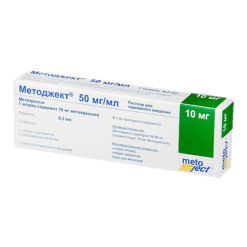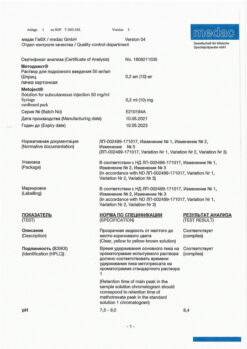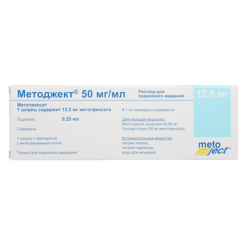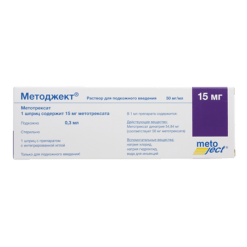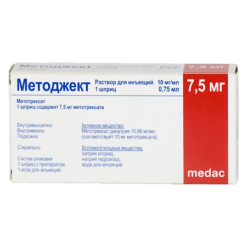No products in the cart.
Description
Antitumor agent from the group of antimetabolites – folic acid antagonists. Acts in the S-phase of mitosis. The mechanism of action is associated with inhibition of synthesis of purine nucleotides and thymidylate as a result of irreversible binding with dihydrofolate reductase, which prevents reduction of dihydrofolate into active tetrahydrofolate. More active against rapidly growing cells. Has some immunosuppressive effect.
Indications
Indications
Acute lymphocytic leukemia, trophoblastic disease, skin cancer, cervical and vulvar cancer, esophageal cancer, squamous cell cancer of the head and neck, renal pelvis and ureter cancer, osteogenic and soft cell sarcoma, Ewing’s sarcoma, lung cancer, breast cancer, testicular and ovarian germ cell tumors, liver cancer, kidney cancer, retinoblastoma, medulloblastoma, penile cancer, lymphogranulomatosis.
Severe forms of psoriasis (in case of ineffectiveness of standard therapy).
Severe form of rheumatoid arthritis (in case of ineffectiveness of standard therapy).
Pharmacological effect
Pharmacological effect
An antitumor agent from the group of antimetabolites – folic acid antagonists. Acts in the S-phase of mitosis. The mechanism of action is associated with inhibition of the synthesis of purine nucleotides and thymidylate as a result of irreversible binding to dihydrofolate reductase, which prevents the reduction of dihydrofolate to active tetrahydrofolate. More active against rapidly growing cells. Has some immunosuppressive effects.
Special instructions
Special instructions
Methotrexate should not be used for ascites, pleural effusion, gastric and duodenal ulcers, ulcerative colitis, gout or nephropathy (including a history).
It is not recommended for use in patients with chickenpox (including recent or after contact with sick people), herpes zoster and other acute infectious diseases.
Before starting therapy and during treatment, the peripheral blood picture, liver and kidney function, and chest x-ray should be monitored.
When treating rheumatoid arthritis or psoriasis, a detailed general blood test should be done at least once a month, and laboratory tests of liver or kidney function at least once every 1-2 months.
When used for psoriasis, local treatment of the disease should not be interrupted. In case of overdose, it is recommended to use calcium folinate (but no later than after 4 hours).
When conducting combination antitumor therapy, special caution should be exercised when using methotrexate in high doses simultaneously with drugs that have a nephrotoxic effect (for example, cisplatin).
It is not recommended to vaccinate patients and their families.
Caution should be used when combining methotrexate (even in low doses) with acetylsalicylic acid.
Experimental studies have established the carcinogenic and mutagenic effects of methotrexate.
Active ingredient
Active ingredient
Methotrexate
Composition
Composition
1 ml – methotrexate disodium 54.84 mg, which corresponds to the content of methotrexate 50 mg.
Excipients: sodium chloride 4 mg, sodium hydroxide to pH 8.5-8.9 q.s., water for up to 1 ml.
Contraindications
Contraindications
Severe liver and/or kidney dysfunction, leukopenia, thrombocytopenia, pregnancy. Methotrexate should not be used in immunocompromised conditions.
Side Effects
Side Effects
From the digestive system: possible ulcerative stomatitis, anorexia, gingivitis, pharyngitis, nausea; rarely – diarrhea, melena, enteritis, pancreatitis; in some cases (with long-term daily use) – liver necrosis, cirrhosis, fatty atrophy, periportal liver fibrosis.
From the hematopoietic system: leukopenia, anemia, thrombocytopenia.
From the side of the central nervous system: feeling of fatigue, dizziness; rarely – headache, aphasia, drowsiness, convulsions.
From the reproductive system: disorders of oogenesis and spermatogenesis, oligospermia, menstrual irregularities, decreased libido, impotence.
From the urinary system: hematuria, cystitis, severe renal dysfunction.
Allergic reactions: chills, decreased resistance to infection; rarely – urticaria, toxic epidermal necrolysis, Stevens-Johnson syndrome.
Dermatological reactions: skin rash, photosensitivity, pigmentation disorders, telangiectasia, acne, furunculosis.
Interaction
Interaction
When used simultaneously with vitamin preparations containing folic acid or its derivatives, the effectiveness of methotrexate may be reduced.
The simultaneous use of NSAIDs in high doses can lead to an increase in the concentration of methotrexate in plasma and to a prolongation of its T1/2, as well as an increase in the concentration of methotrexate not bound to plasma albumin, which in turn increases the toxic effects of methotrexate (primarily on the gastrointestinal tract and hematopoietic system).
When used simultaneously with penicillins, methotrexate (even in low doses) may increase its toxic effects.
When used simultaneously with sulfonamides, especially with co-trimoxazole, there is a risk of increased myelosuppressive effects.
When using nitrous oxide in patients receiving methotrexate, severe unpredictable myelodepression and stomatitis may develop.
When used simultaneously with methotrexate, valproic acid may reduce its concentration in the blood plasma.
Cholestyramine binds methotrexate, reduces its enterohepatic recirculation, which leads to a decrease in its concentration in the blood plasma.
When used simultaneously with mercaptopurine, it is possible to increase its bioavailability due to impaired metabolism during the “first pass” through the liver.
Neomycin and paromomycin reduce the absorption of methotrexate from the gastrointestinal tract.
In patients receiving omeprazole, the concentration of methotrexate in the blood plasma may increase.
When used simultaneously with probenecid, a 3-4 fold increase in the concentration of methotrexate in the blood plasma is possible due to a decrease in its renal excretion.
With simultaneous use of methotrexate with retinoids, the risk of hepatotoxicity may increase.
Salicylates potentiate the effect of methotrexate by reducing its renal excretion.
After a course of treatment with tetracycline, methotrexate, used even in low doses, can have a toxic effect.
With sequential administration of methotrexate and fluorouracil, synergistic action is possible; fluorouracil administered before methotrexate may reduce its toxicity.
Cisplatin is nephrotoxic and may therefore reduce the renal excretion of methotrexate, resulting in increased toxicity.
Increased toxicity is possible when using cyclosporine in patients receiving methotrexate.
Overdose
Overdose
Symptoms: hemorrhagic complications due to accidental overdose with subcutaneous administration of enoxaparin sodium. In case of accidental ingestion of even large doses, absorption of the drug is unlikely.
Treatment: neutralize the effect of enoxaparin sodium by slow intravenous (IV) administration of protamine sulfate. 1 mg of protamine sulfate neutralizes the anticoagulant effect of 1 mg of enoxaparin sodium if the drug was administered no more than 8 hours before the administration of protamine sulfate.
0.5 mg protamine sulfate neutralizes the anticoagulant effect of 1 mg enoxaparin sodium if it was administered more than 8 hours ago or if a second dose of protamine sulfate is necessary.
If 12 or more hours have passed since the administration of enoxaparin sodium, the administration of protamine sulfate is not required. However, even with the introduction of large doses of protamine sulfate, the anti-Xa activity of enoxaparin sodium is not completely neutralized (maximum 60%).
Storage conditions
Storage conditions
At a temperature not exceeding 25 °C. Do not freeze.
Keep out of the reach of children.
Shelf life
Shelf life
2 years. Do not use after the expiration date stated on the package.
Manufacturer
Manufacturer
Oncotech Pharma Production GmbH, Germany
Additional information
| Shelf life | 2 years. Do not use after the expiration date printed on the package. |
|---|---|
| Conditions of storage | At a temperature not exceeding 25 ° C. Do not freeze. Store out of the reach of children. |
| Manufacturer | Onkotek Pharma Production GmbH, Germany |
| Medication form | solution |
| Brand | Onkotek Pharma Production GmbH |
Other forms…
Related products
Buy Metoject, 50 mg/ml 0.35 ml with delivery to USA, UK, Europe and over 120 other countries.


